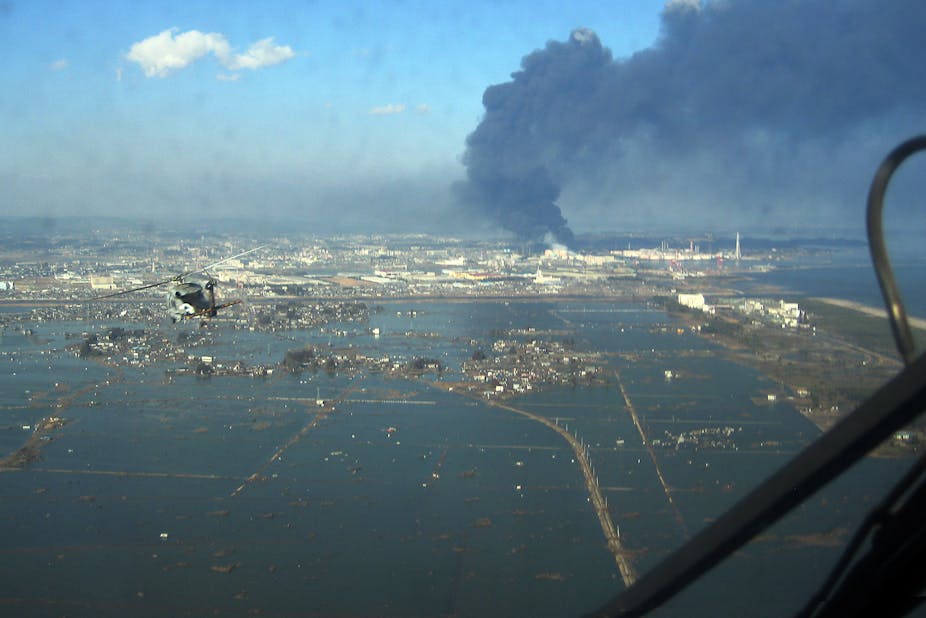The words “environmentalism” and “military” are not typically found in the same sentence. Yet ideas about our vulnerability to environmental change are directly linked to military plans for a third world war.
Scientists planned to fight an unconventional war using the potential threats of the natural environment, calling it “environmental warfare”. Envisioning major threats to populations all over the world, it is from this historical chapter that our ideas about environmental security developed.
While some saw horror in natural disasters, others saw opportunity. In 1960, when a massive earthquake rocked Chile, most commentators noted how helpless humans were to the whims of Mother Nature. But creative military thinkers at NATO thought differently. They saw a frightening future, using hydrogen bombs to manipulate the natural environment.
These detonations could be made thousands of times the size of the ones that destroyed Hiroshima and Nagasaki. They were poised to act as triggers for larger geophysical events. If scientists could find areas of instability in the earth’s crust, a well-placed hydrogen bomb might unleash more quakes. That would send tsunamis across the ocean. Such a bomb could also be used to alter the path of a hurricane, or redirect an ocean current.
NATO explicitly called it environmental warfare. Scientists partnered with the military to work on radiological contamination, biological weapons, and weather control. Other ideas were enormous in scope: nuclear detonations to melt polar ice caps, raising global sea levels and drowning coastal cities. They imagined setting fire to huge expanses of vegetation to change local climates, or targeting vital links in enemy ecosystems.
Today we might regard these ideas as if coming from the delusional Dr. Strangelove, like mad scientists playing with the forces of nature. Yet they had a peculiar logic, given how the strategic bombing of cities at the end of World War II had become an accepted practice. Admiral William Leahy pointed out in the late 1940s that, in a third world war, civilians would be drawn into conflict more than ever before. He and other officers expected to target population centers.
Formerly classified materials document the future they expected. It was a future of global war, of planetary contamination, and of epic struggles to survive an apocalypse. A new “total war” might include the ancient scourges of humankind, such as bubonic plague. Or they might include new ones, such as radioactive contamination.
While imagining a horrific future, scientists and war planners began to ask an important question. Could humans make drastic and long-lasting alterations to the earth?
With today’s concerns about climate change, it is easy to assume that only scientists’ discovery of global warming, combined with public environmental concerns, led us to believe humans were heading toward catastrophe. But as I discovered researching my book, Arming Mother Nature, this is a simplification. It runs the risk of ignoring those who thought the most deeply about vulnerabilities to environmental change.
Boundaries between military questions and environmental ones were hazy throughout the Cold War. Sometimes the same scientists who worked on military questions then turned their expertise toward peacetime environmental issues. For example, Oxford botanists who published on biodiversity also advised on agricultural defence, and helped British military commanders in Malaya kill enemy crops. The US Air Force worried their reliance on technology made Americans more susceptible to disease and starvation, which could be exploited by the Soviets.
Several of the biologists, oceanographers, and atmospheric scientists who advised governments on the 1977 treaty to ban military uses of environmental modification (the ENMOD convention) also helped craft the first studies of anthropogenic climate change. Many of these scientists had spent years trying to imagine whether large-scale catastrophic changes were really possible. They also developed ideas about the long-term consequences of human action.
As scientists, military leaders, and diplomats tried to figure out how realistic environmental weapons were, in doing so they fundamentally shaped conversations about peacetime changes to the environment.
The collaboration between scientists and the armed forces during the Cold War created a worldview obsessed with environmental change and vulnerability. For nearly half a century, military establishments supported research on environmental warfare. They kept up global surveillance of the atmosphere and oceans. They made it their mission to assess the vulnerabilities of their homelands and those of others.
As environmental scientists were trying to harness the power of nature against their foes, they discovered how vulnerable humanity was to a changing environment, even in the absence of war.

